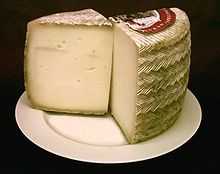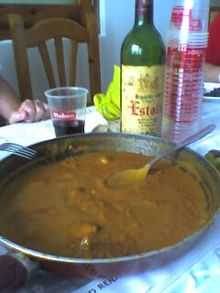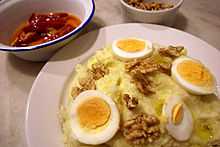Castilian-Manchego cuisine





Castilian-Manchego cuisine refers to the typical dishes and ingredients in the cuisine of Castile–La Mancha region of Spain. These include pisto (a vegetable stew with tomato sauce), gazpacho manchego, Manchego (a type of cheese), the white wine of La Mancha, and the red wine from Valdepeñas (DO).
The dishes and specialties of the region are generally sober and sensible, reflecting a modest, rural origin. They contain a limited number of ingredients. Ingredients tend to be those most easily accessible by the locals. Dishes tend to be high in calories, ideal for the diets of laborers, farmers, and shepherds. The cuisine of this area was popularized by Cervantes in his Don Quixote de la Mancha, where a number of traditional dishes are mentioned.
Staples
Local traditional staples in La Mancha were gachas de almorta, made with grass pea (Lathirus sativus) flour, and tortas de gazpacho, a flat bread that is the base for the "gazpachos", an elaborate dish appearing in El Quixote under the name of "galianos". Nowadays bread is much more widespread.
Fruits and Vegetables
There are not many purely vegetarian dishes in the region. One of the local vegetables are Silene vulgaris leaves, known as (collejas), quite uncommon as a vegetable elsewhere. Some traditional vegetable-based dishes are pisto manchego, pipirrana (a salad of onion, tomato, and cucumber), asadillo de la Mancha (roasted red peppers), and gazpacho viudo. The berenjenas de Almagro are a variety of small aubergines that are grown in Almagro, Ciudad Real. These are seasoned and pickled according to a traditional recipe and usually eaten as a snack or side-dish.
A common ingredient found in almost all local dishes is garlic. A local sweet pepper, the ñora, is also a main ingredient of many dishes.
Meat and Fish
There are many local meat dishes, which consist primarily of sheep, goat, and, to a lesser degree, beef. The most important dishes are carcamusas (typical of Toledo), chanfarina, roast lamb, cuchifrito, migas, gallina en pepitoria (chicken a la pepitoria), salpicón, paturrillo, and zarajos. In areas where there is a lot of hunting, a number of game based dishes are also popular, such as conejo al ajillo (rabbit with garlic), liebre a la cazadora (hare hunter-style), and caldereta manchega.
The traditional fish of the area is bacalao (salt cod), which can be found in a limited number of dishes.
Cheeses
Queso manchego, or "cheese from La Mancha", is the best-known cheese from the area. Made from the milk of local sheep (Ovis Aries Ligeriensis) found in the pastures year-round. The cheese is hard, with a strong taste, mild bite, and greasy texture. There are many individual types of queso manchego depending on curing time and tradition (some are submerged in olive oil while curing).
Wines
Wine production is very important to the region, which has many protected designations of origin for the area. The major PDO is D.O. La Mancha, but others include: D.O. Valdepeñas in Ciudad Real; D.O. Méntrida in Toledo; D.O. Jumilla and D.O. Manchuela in Albacete; D.O. Mondéjar in Guadalajara, etc. In addition there are numerous home-made wines, such as the sacramental wines known as "pitarras."
Entrees
Desserts
- Almendrados
- Alajú
- Amarguillos
- Arrope
- Arroz con leche (rice pudding)
- Bienmesabe
- Buñuelos
- Copa imperial
- Dormido del corpus
- Hojuelas
- Leche frita
- Mantecados
- Mazapán / Mazapán de Toledo
- Miguelitos, of La Roda, speciality
- Pestiños
References
- "La cocina del Quijote",
- "Costumbres y cocina manchega",
- Consejo regulador del Queso Manchego